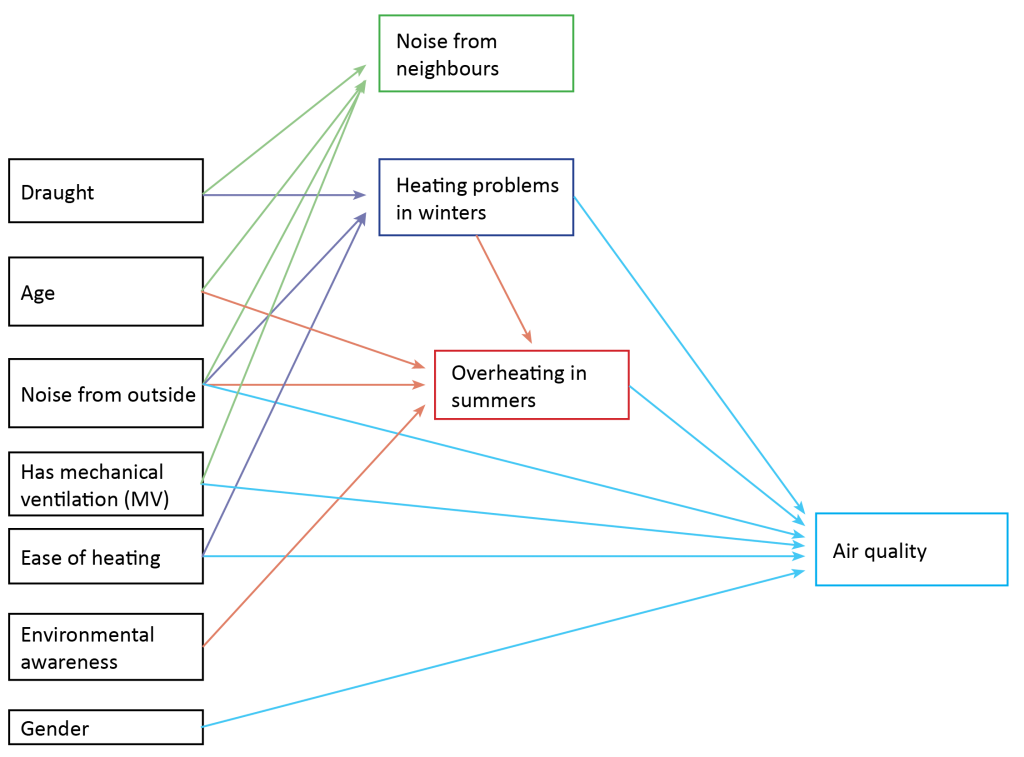STU/EDIES – THE RELATIONSHIP BETWEEN A BUILDING’S ENERGY PERFORMANCE AND DWELLING SATISFACTION
Editie: 29 - Artificial Intelligence in the Built Environment
Published on: 26 januari 2022
The built environment covers a substantial share of the total greenhouse gas emissions in the Netherlands (CBS, 2020). In reducing these emissions, the energy performance of dwellings is improved through changes such as: ventilation systems, glazing, and insulation levels. In the Dutch social housing sector, tenants have limited control in the renovations that take place. To better take the preferences of tenants in the social housing sector into account, this research aims to analyse the relationship between the energy performance of dwellings and the dwelling satisfaction of tenants in the social housing sector. Additionally, it is important that the tenants achieve savings on energy costs to increase the affordability of their dwelling and reduce the risk of fuel poverty[1], that 10% of Dutch households are dealing with (Energie Armoede Toolkit, 2020).
Research approach
Based on the framework defined by Weidemann & Anderson (1985) and literature on dwelling satisfaction of tenants, the characteristics that determine dwelling satisfaction are defined as: the objective energy performance (glazing, insulation, energy label), the socio-demographics of the tenant, perceived building physical performance of the dwelling (thermal comfort, air quality, noise), and external factors related to the dwelling context (dwelling complex[2], satisfaction with the association).
With the variables found in the literature study, a quantitative study is conducted. The data was collected via an online questionnaire and combined with the existing dataset of energy performance provided by the consultancy company Atriensis. Five housing associations were involved in distributing the online questionnaires with the tenants of the relevant dwelling complexes. This resulted in a total of 4835 households that were contacted. Of these households, 262 complete surveys were retrieved. Most outcomes originated from the south of the Netherlands, consisting predominantly of residents from Roosendaal, followed by Breda, the northeast of Brabant, Limburg, and Noord-Holland.
Analysis method
To predict the outcomes of the conceptual model, multiple regression analysis was applied using Ordinary Least Squares (OLS) and Fixed effect models. By estimating the OLS model, the linear relationship between the objective energy performance, socio-demographics, perceived building physical performance, and dwelling satisfaction is estimated.
The fixed effect model differs from the OLS by including complex fixed effects. These are a series of dummy variables that represent the complexes the dwellings are assigned to. By including these fixed effects, unobserved characteristics related to the complex are taken into account.

Figure 1. Identification of twins within a dwelling complex.
To effectively apply the fixed effects, dwellings are compared that are nearly identical in dwelling characteristics and context. Dwellings that match in terms of these characteristics are described as “twins”. In figure II, it is illustrated how the twins within a dwelling complex are identified. Here it can be seen that for each dwelling complex, a dwelling of lower energy label (D, E, F, or G) is matched with a similar dwelling within the same complex that has a higher energy performance (C, B, A, or higher). To identify dwellings of similar characteristics, focus is placed on single-family dwellings in the Dutch social housing sector, that were built between 1945 and 1984. It expected that, among these twins, a different energy performance results in a different housing satisfaction of the tenant.
Additionally, path analysis is applied to analyse the relationships between the independent variables and the perceived building physical performance of a dwelling. This analysis method estimates relationships such as: the relationship between thermal comfort and draughts, or the relationship between age of a tenant and perceived air quality.

Figure 2. Conceptual model for path analysis
Results
In Figure 3, the characteristics that have a significant relationship with dwelling satisfaction are shown. These include: environmental awareness, heating problems in winters, problems with air quality, and mould spots. The outcomes for heating problems and mould confirm the findings of Sinnot (2016), Suffolk & Poortinga (2016), and Broderick et al (2017).

Figure 3. Significant relationships with dwelling satsifaction according to the OLS and fixed effect models.
The bottom bars in the graph predict the relative increase in dwelling satisfaction as a result of a 1 point increase in rating for the measured characteristic. The top bars show the maximum relative increase that can be reached by improving the characteristic. For example, a tenant who never experiences problems with air quality is expected to rate their dwelling 2 points higher compared to a tenant living in similar conditions who very often experiences these problems. The dwelling satisfaction is scaled from 1 to 10. Thus, if the less satisfied tenant has a rating of 6, the other tenant is expected to have a rating of 8 out of 10. Interestingly, the relative importance does not differ greatly between characteristics. This indicates that all variables should be treated equally when aiming to improve dwelling satisfaction.
Almost all relationships were identical between the OLS and Fixed effects model. One exception is that draughts have no significant relationship with dwelling satisfaction according to the fixed effects model. From this it was found that the relationship between draughts and dwelling satisfaction is not robust and strongly depends on the research method and context.
In Figure 4, the significant relationships found from the path analysis are shown. From this figure, it can be seen that among the energy performance indicators, only mechanical ventilation (MV) has a significant relationship with noise from neighbours and air quality. Interestingly, the relationship with air quality is negative, which suggests more frequent air quality problems if MV is present. This was also found in previous research. (Lepkova, Butkiene, & Bełej, 2016; Sinnot, 2016; Yang et al, 2020).
Regarding socio-demographics, it was found that older tenants (70+ years) less often reported problems with overheating, noise from neighbours, and (among the 80+ years age group) air quality compared to younger tenants. This was also observed by experts in the field. Additionally, more environmentally aware tenants more often perceived problems with overheating in summers.
Also relationships between the perceived performance indicators are found. As was expected from the literature, draughts have a significant positive relationship with noise from neighbours and cold in the dwelling (Vakalis et al, 2019). Additionally, it was found that thermal comfort and ease of the heating system both have a positive relationship with perceived air quality.

Figure 4. Structural equation model for path analysis.
Conclusion
The research outcomes help to estimate the complete relationship between energy-related performance of a dwelling and the dwelling satisfaction of the tenant. In Figure 5, an overview can be seen of the relevant indicators to consider when improving the dwelling satisfaction of the tenants. The variables are ordered from top to bottom by relative importance.

Figure 5. Important indications for a tenant’s dwellings satisfaction.
When aiming to increase dwelling satisfaction, one should take trust in the housing association, air quality, heating problems in winters, environmental awareness, and mould problems as the main focus. Namely, these variables are important across all tenants independent of the energy performance or complex of the dwelling. Interestingly, the energy performance itself has no significant relationship with dwelling satifcation.
The trust in the association is found to have the strongest relationship and should be prioritized to ensure satisfied tenants. On the other hand, the relationship could also indicate that dwelling satisfaction causes a higher trust in the association. Considering the perceived building performance, these characteristics are relevant for all dwellings regardless of the energy performance. Thus, it is important to consider that maintenance in a dwelling regarding leakage, heat loss, ventilation and overall humidity are quickly resolved in a dwelling. On the other hand, if a tenant is more satisfied with their dwelling overall, they are also less likely to report problems in their dwelling. Additionally, draughts are considered an important indicator for dwelling satisfaction, although this is not found across all contexts. It is therefore advised to check whether tenants perceive nuisance regarding draughts before determining a fitting renovation strategy. Finally, by improving the environmental awareness of tenants, the dwelling satisfaction may increase as well. The awareness may be improved by informing tenants about measures for saving energy use or reducing waste. On the other hand, a higher dwelling satisfaction may also result in higher environmental awareness among tenants.
Overall, the research helped to offer a more complete overview of the relationship between energy performance and dwelling satisfaction of tenants in the social housing sector. As the energy efficiency alone does not improve the tenant’s satisfaction, it is of strong importance to take the other preferences and nuisances of tenants into account. This ensures that sustainable housing is also considered as satisfying housing for its tenants.
[1] Fuel poverty occurs when a tenant has to spend a substantial amount of their income on gas and electricity costs.
[2] A dwelling complex is a group of dwellings of social housing that are located within the same neighbourhood and owned by the same housing association. The dwellings within a complex often have a similar dwelling type and construction year.
Supervisors
S.J.E. Maussen
T.A. Arentze
I.V. Ossokina
D. Noy (Company representative)
References
Lepkova, N., Butkiene, E., & Bełej, M. (2016). Study of Customer Satisfaction with Living Conditions in New Apartment Buildings, Real Estate Management and Valuation, 24(3), 52-70. doi: https://doi.org/10.1515/remav-2016-0021
Sinnott, D. (2016). Dwelling airtightness: a socio-technical evaluation in an Irish context, Build. Environ. 95. P. 264-271.
Yang, S., Pernot, J.G., Jörin, C.H., Niculita-Hirzel, H., Perret, V., Licina, D. (2020). Energy, indoor air quality, occupant behavior, self-reported symptoms and satisfaction in energy-efficient dwellings in Switzerland. Build. Environ., 171
Weidemann, S., & Anderson, J. (1985). A conceptual framework for residential satisfaction. In I. Alman & C. Werner (Eds.), Home environments (pp. 153–182). London: Plenum.
Suffolk C., Poortinga W. (2016) Behavioural Changes After Energy Efficiency Improvements in Residential Properties. In: Santarius T., Walnum H., Aall C. (eds) Rethinking Climate and Energy Policies. Springer, Cham. https://doi.org/10.1007/978-3-319-38807-6_8
Energie Armoede Toolkit (2020). Effectieve aanpak energiearmoede. Retrieved 25-11-2020, from http://energiearmoede.nl/
Broderick, Á., Byrne, M., Armstrong, S., Sheahan, J., Coggins, A.M. (2017). A pre and post evaluation of indoor air quality, ventilation, and thermal comfort in retrofitted co-operative social housing. Build. Environ., 122, pp. 126-133, 10.1016/j.buildenv.2017.05.020
CBS (2020). Welke sectoren stoten broeikasgassen uit? Retrieved 9-11-2020, from https://www.cbs.nl/nl-nl/dossier/dossier-broeikasgassen/hoofdcategorieen/welke-sectoren-stoten-broeikasgassen-uit-
Vakalis, D., Touchie, M., Tzekova, E., MacLean, H.L., Siegel, J.A. (2019) Indoor environmental quality perceptions of social housing residents. Build. Environ., 150, pp. 135-143, 10.1016/j.buildenv.2018.12.062
Mail the editors
